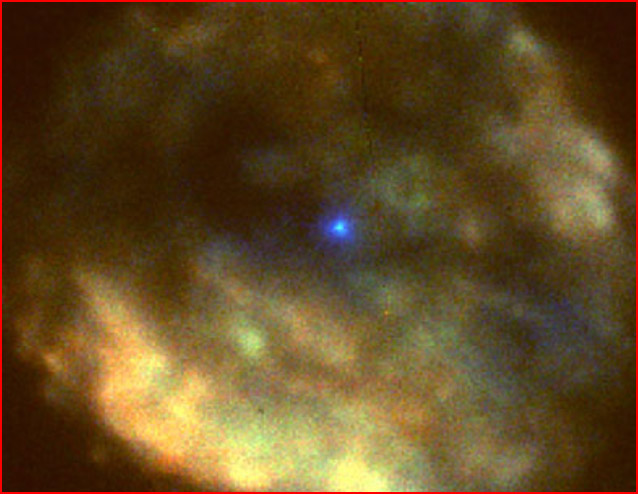
home •
about •
essential guide •
picture of the day •
thunderblogs •
news •
multimedia •
predictions •
products •
get involved •
contact
picture of the day archive subject index
XMM-Newton's view of supernova remnant RCW 103
Feb 06, 2007
“Neutron Star” Refutes Its Own ExistenceMore difficulties for the standard theory of supernovae and “neutron stars”—a misbehaving “supernova remnant.”
In the past few decades of space exploration, we have grown accustomed to seeing certain words and phrases in the scientific press release. It would be difficult or impossible to enumerate all of the instances when space discoveries have been met with shock and perplexity by mainstream investigators. "This is a complete surprise"..."This should not be"..."We're not sure"...Given the confidence with which the cosmological big picture is presented in scientific media, one would think that such statements would be rare, but in fact, almost none of the milestone findings of the space age were expected.
Recently, astronomers announced the discovery of a "mystery object" that, according to conventional wisdom, should be a very "young" neutron star, yet behaves like one that is several million years old. According to the Space.com report, "Embedded in the heart of a supernova remnant 10,000 light-years away is a stellar object the likes of which astronomers have never seen before in our galaxy. At first glance, the object looks like a densely packed stellar corpse known as a neutron star surrounded by a bubble of ejected stellar material, exactly what would be expected in the wake of a supernova explosion.”
But astronomers observed the star for just over 24 hours with the European Space Agency’s XMM Newton X-ray satellite, and were stunned by what they saw. Its emission cycles were tens of thousands of times longer than theory had postulated for “a freshly created neutron star.”
"The behavior we see is especially puzzling in view of its young age, less than 2,000 years," said study leader Andrea De Luca of the Istituto Nazionale di Astrofisica (INAF) in Milan. "For years we have had a sense that the object is different, but we never knew how different until now," De Luca said.
Neutron stars are claimed to be the remnants of massive stars – bloated red supergiants -- that have collapsed after the expiration of their "nuclear furnace,” resulting in a supernova. This event is said to explain the pulsar remnant of some supernovae. Pulsars exhibit bursts of radiation up to thousands of times a second. To account for this, astronomers imagined a super-collapsed stellar object, spun up by the collapse like a skater pulling in his or her arms, emitting a rotating beam of x-rays spinning like the beam of a lighthouse up to thousands of times per second.
Conventional theory would say that the offending "neutron star" in this case is spinning far too slowly for one of its imagined age of a couple of thousand years. According to Electric Universe proponents, this kind of contradiction is inevitable in the investigation of "neutron stars", because they do not exist. They were a theoretical invention based on a fundamental misinterpretation of the nature of stars, and hence of supernovae.
From an Electric Universe point of view, stars are formed in a plasma “pinch,” one of the most common features in the observed behavior of electric currents in plasma. Large magnetic fields have been detected in galaxies, and these fields indicate that huge electric currents flow in circuits through the galaxies. In fact, stars are both sparked and powered by the same electric currents. Stars behave as electrodes in a galactic glow discharge.
The EU hypothesis is that supernovae are not caused when a star loses its "nuclear furnace" and collapses, but rather they are due to a catastrophic galactic electric discharge event focused on a hapless star. And observation in recent years has only supported this model. For example, supernovae occur with a periodicity in any given galaxy that highlight their connectedness via galactic circuits. Stars are not self-contained sources of energy.
Supernova 1987A was the closest supernova event since the invention of the telescope. It was doubly special because the progenitor had been examined before the explosion. Electrical theorists say it was not a coincidence that this “best example” violated all the “rules.” The progenitor was not the expected red supergiant star, but a BLUE supergiant, perhaps 20 times smaller than a red supergiant. Moreover, the structure of Supernova 1987A, with three axially aligned rings and a string of bright beads forming the equatorial ring, has no place in the standard model of supernovae. Everything about this exploding star, however, has direct counterparts in laboratory experiments with high-energy plasma discharge. And plasma cosmologists using electric circuit theory have explained all of the complex features of the pulsing radiation from supernova remnants without the need for a hypothetical "super condensed object" like a neutron star.
The question now is, will astronomers continue to invent more ad hoc exceptions to a theory already too complicated by exceptions, or will they pause sufficiently to wonder if a new perspective is possible on the burgeoning zoo of supernovae types and odd "neutron stars?"
![]()
home •
thunderblogs •
forum •
picture of the day •
resources •
team •
updates •
contact us
EXECUTIVE EDITORS:
David Talbott, Wallace Thornhill
MANAGING EDITORS:
Steve Smith, Mel Acheson
CONTRIBUTING EDITORS: Michael Armstrong, Dwardu Cardona,
Ev Cochrane,
C.J. Ransom, Don Scott, Rens van der Sluijs, Ian Tresman
WEBMASTER: Brian Talbott
Copyright 2007: thunderbolts.info
